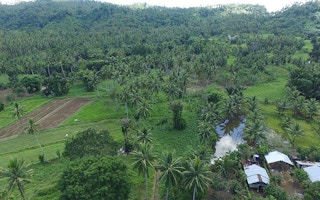Yoyon remembers being elected head of his village back in 2010, here on the southwestern coast of the Indonesian island of Sumatra, following a spate of arrests of his fellow villagers.
Those arrested were accused of farming in Bukit Daun, a protected forest. The last arrests that Yoyon, who goes by one name, can recall came two years before his election, when six villagers were held.
“I’ve lost count of how many locals have been detained,” he said in an interview.
The village of Taba Padang is one of many scattered across Indonesia, where impoverished communities have for generations lived within or nearby forests. Their efforts to make a living from the natural riches around them have often run up against the interests of those with more power, such as the government or private companies.
“I became so concerned by the problem and wanted it to end,” Yoyon said. Eventually he was introduced to the government’s “village forest” scheme, known locally as hutan desa.
Under the program, each household receives the rights to manage a 1.5-hectare (3.7-acre) plot in the protected forest. They are prohibited from clearing the land for a plantation, but may grow fruit or trees or coffee in the forest’s understory. In exchange, they must agree to protect the animals that live there and guard against fires.
The program also provides farming guidance and seed supplies for new farmers. To ensure compliance, officials conduct regular inspections every five years.
It took almost four years for Yoyon to obtain the necessary permits granting the village control over 9.95 square kilometers (3.84 square miles) of the protected forest.
“We almost gave up,” he said. “Now, the people no longer feel worried about getting arrested when they are working on their farms.”
Yoyon said the area was currently managed by 470 households, who grow coffee, pepper, durian, rattan and other produce. He also noted that water supplies now flowed through the forest farms to the people’s houses without any disruption.
Fauzi, one of the farmers, said his income had increased significantly since the program was fully implemented.
“I can now use a motorbike to carry my harvests and save up money,” he said.
Yoyon said the area also had tourism potential, with its four waterfalls, a hot spring, and host of exotic flowering plants such as Hornstedtia rubra, Amorphophallus gigas and Armophophallus titanum.
“We’ve stopped cutting down trees, and instead plant new ones,” Yoyon said. “We can now prove that forest conservation equals social welfare.”
In August, the village’s success in managing its hutan desa drew praise from the Indonesian government. The Ministry of Environment and Forestry named it the best village forestry management in the country this year.
“Hopefully we can continue to increase the people’s welfare and protect the forest,” Yoyon said.
This story was published with permission from Mongabay.com. Read the full story.

















